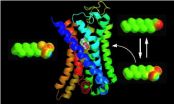(Press-News.org) Diabetes has become a major public health crisis in China, with an annual projected cost of 360 billion RMB (nearly 35 billion British pounds) by 2030, but a new collaborative approach to care that uses registries and community support could help improve diabetes care, according to a new three-part Series about diabetes in China published in The Lancet Diabetes & Endocrinology.
China has the largest number of people with diabetes of any country in the world, and the disease has reached epidemic proportions in the adult population [Paper 1]. In 1980, less than 1% of Chinese adults had diabetes, but this increased to almost 12% (113.9 million adults) by 2010 (see table page 4). Latest estimates indicate that around half of Chinese adults have prediabetes, putting them at high risk of diabetes and multiple related illnesses.
"Especially alarming is that most adults with diabetes are undiagnosed (70% of all cases), only a quarter of people with diabetes have received treatment and that the disease is controlled in just 40% of those treated"*, says Professor Guang Ning, one of the Series authors, and immediate past president of the Chinese Endocrine Society, who led the Chinese national survey of diabetes in 2010.
Worryingly, say the authors, these figures herald a major epidemic of diabetes-related complications such as cardiovascular disease, chronic kidney disease, and cancer in the near future unless there is effective national intervention.
The epidemic is the result of rapid economic development and urbanisation that has culminated in an "obesogenic environment" characterised by food abundance, physical inactivity, and psychosocial stress [Paper 1]. What is more, Chinese people are particularly susceptible to type 2 diabetes compared with white people, and they tend to develop the disease at a much lower body mass index (BMI). The average BMI of Chinese patients with diabetes is 25 kg/m2, compared with 30 kg/m2 in non-Asians [Paper 2].
Over the past 30 years, China's standard of living and life expectancy have improved for many, but the ageing population, dietary changes, reduced physical activity, and exceptionally high rates of smoking have contributed to the diabetes epidemic. The health consequences of this epidemic threaten to overwhelm health-care systems and urgent action is needed, warn the authors.
In future decades, the double burden of an ageing population and rising rates of young-onset diabetes will have an enormous toll on productivity and health-care systems [Paper 1]. Series co-leader Professor Ronald Ma, from the Chinese University of Hong Kong, explains: "Given the increased long-term risk of complications in people with young-onset diabetes, the potential economic and health burden associated with this epidemic is very alarming. In 1993, the cost of diabetes treatment in China was 2.2 billion RMB, but the projected cost for 2030 is 360 billion RMB, which highlights the critical importance of prevention."*
There is much to be done, says Professor Juliana Chan from the Chinese University of Hong Kong, who co-led the Series: "While we await the results of long-term strategies from the China National Plan for Non-Communicable Disease Prevention and Treatment (2012-15) including tobacco control and universal screening for gestational diabetes, we advocate the use of a targeted proactive approach to identify people at high risk of diabetes for prevention, and of private-public community partnerships that make care more accessible, sustainable, and affordable focusing on registry, empowerment, and community support."*
For example, community-based coordinating centres and targeted screening programs in schools and workplaces, run by trained community health workers and graduate students under medical supervision, could identify high-risk individuals and provide education about the benefits of early intervention, treatment and continuing support [panel, Paper 1, page 8]. Additionally, more research is needed to identify the best drug treatments for Chinese people with type 2 diabetes, who have several unique clinical characteristics [Paper 3].
According to Professor Chan, "As this epidemic continues to unfold, every individual must join in the grand challenge of creating a multidimensional solution to minimise its effects on societal, family, and personal health."*
INFORMATION:
NOTES TO EDITORS:
*Quotes direct from authors and cannot be found in text of Article.
The Lancet Diabetes & Endocrinology: 1 in 4 people with diabetes worldwide live in China, but a new approach could help transform their care
2014-09-11
ELSE PRESS RELEASES FROM THIS DATE:
Study: Role of emergency contact is mistaken for advance directive
2014-09-11
DETROIT – More than 95 percent of patients treated in an Emergency Department mistake their emergency contact as the designated medical decision maker for end-of-life care, according to a new study by Henry Ford Hospital in Detroit.
The study is being presented Wednesday at the 20th International Congress on Palliative Care in Montreal.
Erin Zimny, M.D., a Henry Ford Emergency Medicine and Palliative Care physician and a study co-author, attributes the misunderstanding to health care practitioners routinely asking patients for their emergency contact information without ...
Genomic analysis reveals that a high-risk leukemia subtype becomes more common with age
2014-09-11
More than one-quarter of young adults with the most common form of acute lymphoblastic leukemia (ALL) have a high-risk subtype with a poor prognosis and may benefit from drugs widely used to treat other types of leukemia that are more common in adults, according to multi-institutional research led by St. Jude Children's Research Hospital investigators. The study appears in the current issue of The New England Journal of Medicine.
ALL is the most common childhood cancer. The research focused on a subtype of ALL known as Philadelphia chromosome-like ALL (Ph-like ALL). In ...
Chemists discover way nose perceives common class of odors
2014-09-11
Biologists claim that humans can perceive and distinguish a trillion different odors, but little is known about the underlying chemical processes involved. Biochemists at The City College of New York have found an unexpected chemical strategy employed by the mammalian nose to detect chemicals known as aldehydes.
According to a team led by CCNY Associate Professor of Chemistry Kevin Ryan and Columbia biologist Stuart Firestein, some of the nose's many aldehyde receptors don't detect the aldehyde by its structure and shape directly. Rather, the aldehyde is recognized by ...
Small weight gain can raise blood pressure in healthy adults
2014-09-10
Gaining just five pounds can increase your blood pressure, according to a study presented at the American Heart Association's High Blood Pressure Research Scientific Sessions 2014.
Many people understand the health dangers of large amounts of extra body weight, but reasearchers in this study wanted to see the impact of a small weight gain of about five to 11 pounds.
"To our knowledge, for the first time, we showed that the blood pressure increase was specifically related to increases in abdominal visceral fat, which is the fat inside the abdomen," said Naima ...
Using plants to produce enzyme may provide treatment for high blood pressure in lungs
2014-09-10
Using plant leaves to produce and deliver a key enzyme may improve treatment for life-threatening high blood pressure in the lungs, according to a study presented at the American Heart Association's High Blood Pressure Research Scientific Sessions 2014.
"Current therapies for pulmonary hypertension don't cure the underlying disorder and the long-term prognosis is poor, even with treatment," said Vinayak Shenoy, Ph.D., the study's lead author and an assistant research scientist at the University of Florida in Gainesville. "There is an urgent need to discover potential ...
Restricting calories may improve sleep apnea, blood pressure in obese people
2014-09-10
— Restricting calories may improve obstructive sleep apnea and reduce high blood pressure in obese adults, according to a study presented at the American Heart Association's High Blood Pressure Research Scientific Sessions 2014.
People with sleep apnea may experience pauses in breathing five to 30 times per hour or more while sleeping. It prevents restful sleep and is associated with high blood pressure, arrhythmia (abnormal heart rhythm), stroke and heart failure.
In a 16-week ramdomized clinical trial, researchers analyzed 21 obese people 20-55 years old with a history ...
Can your blood type affect your memory?
2014-09-10
MINNEAPOLIS – People with blood type AB may be more likely to develop memory loss in later years than people with other blood types, according to a study published in the September 10, 2014, online issue of Neurology®, the medical journal of the American Academy of Neurology.
AB is the least common blood type, found in about 4 percent of the U.S. population. The study found that people with AB blood were 82 percent more likely to develop the thinking and memory problems that can lead to dementia than people with other blood types. Previous studies have shown that people ...
Angling chromium to let oxygen through
2014-09-10
RICHLAND, Wash. -- Researchers have been trying to increase the efficiency of solid oxide fuel cells by lowering the temperatures at which they run. More efficient fuel cells might gain wider use in vehicles or as quiet, pollution-free, neighborhood electricity generating stations. A serendipitous finding has resulted in a semiconducting material that could enable fuel cells to operate at temperatures two-thirds lower than current technology, scientists reported August 18 in Nature Communications.
In an attempt to create a metal oxide with the properties of metal, researchers ...
Association between sunshine and suicide examined in study
2014-09-10
Lower rates of suicide are associated with more daily sunshine in the prior 14 to 60 days.
Light interacts with brain serotonin systems and possibly influences serotonin-related behaviors. Those behaviors, such as mood and impulsiveness, can play a role in suicide.
The authors examined the relationship between suicide and the duration of sunshine after mathematically removing seasonal variations in sunshine and suicide numbers. They analyzed data on 69,462 officially confirmed suicides in Austria between January 1970 and May 2010. Hours of sunshine per day were ...
Study examines vitiligo, alopecia areata and chronic graft vs. host disease
2014-09-10
Vitiligo (depigmentation of the skin) and alopecia areata (AA, patchy or complete hair loss) in patients with chronic graft-vs-host disease (GvHD) following a stem cell transplant appear to be associated with having a female donor and the sex mismatch of a female donor and male recipient.
GvHD is a frequent complication of donor stem cell transplants because donor cells can attack the recipient's body and cause death and other illnesses. The skin is the most commonly affected organ. The underlying biology of chronic GvHD has not been fully explained. The authors ...


